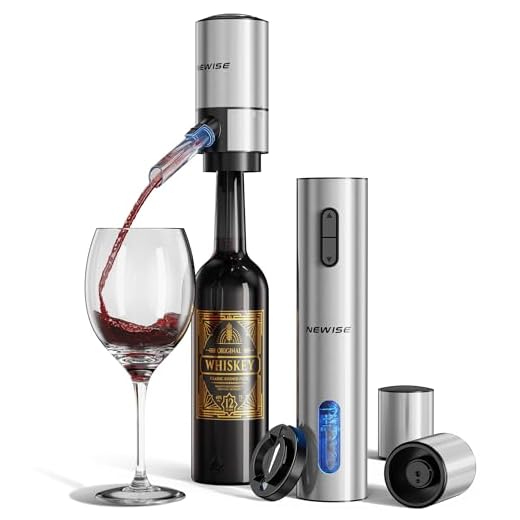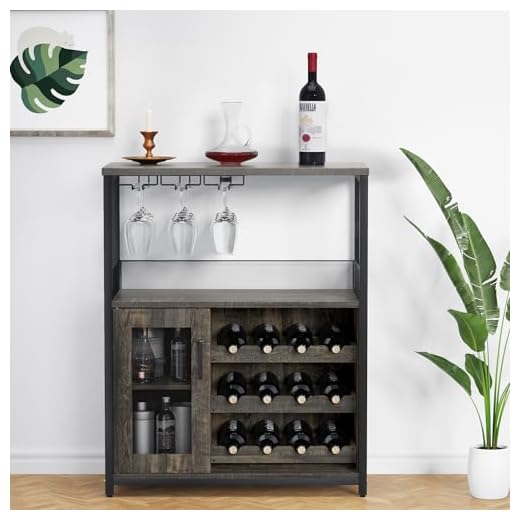



For optimal preservation, placing these beverages in a cooler environment is not advisable. However, short-term refrigeration can be acceptable, especially if the bottle has been opened. Aim for a temperature between 55°F and 65°F for best results.
When considering long-term storage, a dedicated wine cellar or a wine fridge is preferable. These specialized units maintain consistent temperatures and humidity levels, crucial for aging. Fluctuations in temperature, often experienced in standard household refrigerators, can negatively impact flavor and aroma profiles.
If a bottle is partially consumed, sealing it tightly and storing it in a chilled environment for a few days can help retain its character. Use a vacuum pump for best results, as this minimizes oxidation. Just remember to allow it to warm slightly before serving to enhance its bouquet.
Storage Recommendations for Red Varietals in Refrigeration
For optimal preservation, avoid long-term storage of these beverages in a cold appliance. However, short-term chilling can enhance enjoyment, especially during warmer months. If serving chilled, aim for a temperature range of 55°F to 65°F (13°C to 18°C). A few hours prior to serving is sufficient for this purpose.
Identifying the Right Conditions
Ensure that the bottles are laid horizontally to keep the cork moist, preventing air from entering. Maintain a stable environment, free from vibrations and direct sunlight. If the space is too cold, consider transferring to a more moderate area after a short chill, as prolonged exposure to low temperatures can dull flavors and aromas.
Post-Opening Considerations
Once opened, sealing with a vacuum stopper and refrigerating helps maintain freshness for several days. Aim to consume within three to five days for the best taste experience. Remember, oxidization can alter the profile significantly, so monitor the bottle closely.
Understanding the Ideal Temperature for Red Wine
For optimal enjoyment, aim for a range of 55°F to 65°F (13°C to 18°C) for serving this beverage. This temperature spectrum allows the complex flavors and aromas to shine through, enhancing your tasting experience.
Here are key points to consider:
- Light-bodied options, such as Pinot Noir, are best served around 55°F (13°C).
- Medium-bodied varieties, like Merlot, thrive at approximately 60°F (16°C).
- Full-bodied choices, including Cabernet Sauvignon, excel at 65°F (18°C).
Using a thermometer can help ensure accuracy. For those without one, a simple rule is to chill the bottle for about 30 minutes before serving. This strategy effectively lowers the temperature without over-cooling.
Storing this beverage at ideal conditions contributes significantly to its longevity. Avoid direct sunlight and heat sources, opting for a consistent environment. If you’re looking for the right food pairings, consider options like best dog food for diarrhea issues to complement your meal.
Remember, temperature plays a pivotal role in the overall experience, so approach it with care for the best results.
Impact of Refrigeration on Wine Flavor and Aroma
Storing this beverage at lower temperatures can significantly alter its sensory profile. While chilling can enhance certain attributes, it often detracts from the complexity and depth associated with warmer serving conditions.
Temperature fluctuations can mute the aromatic compounds that contribute to the bouquet. For instance, delicate notes such as cherry, plum, and spice may become less pronounced. The ideal range for serving typically hovers around 60-65°F (15-18°C). Below this range, many varietals lose their characteristic nuances.
Acidity and tannins also respond to cooler environments. In lower temperatures, acidity can appear sharper, while the perception of tannins may shift, leading to a less harmonious mouthfeel. This imbalance can lead to a less enjoyable tasting experience.
To maintain the integrity of flavors, consider short-term refrigeration for preserving unfinished bottles. Ideally, allow the beverage to rest at room temperature for a brief period before consumption to restore some of its aromatic qualities.
| Temperature Range (°F) | Flavor Profile | Recommended Action |
|---|---|---|
| Below 50 | Muted aromas, sharp acidity | Let it warm up before serving |
| 50-60 | Subdued flavors, acceptable | Allow slight warming |
| 60-65 | Optimal balance, full expression | Serve immediately |
| Above 65 | Overly alcoholic, loss of structure | Chill briefly if needed |
Understanding these nuances can enhance enjoyment and appreciation, ensuring each bottle delivers its intended experience. Always consider the varietal’s characteristics and your personal preferences when deciding on storage methods.
Best Practices for Storing Opened Wine in the Fridge
After opening a bottle, the first step is to reseal it properly. Use a cork or a specialized wine stopper to minimize air exposure. This helps preserve the flavor and aroma of the beverage.
Temperature Settings
- Maintain a consistent temperature around 50-55°F (10-13°C).
- Avoid placing the bottle in the coldest part of the cooling unit, as it can negatively affect the taste.
Storage Duration
Consume within 3-5 days for optimal enjoyment. After this period, the quality may decline significantly.
For longer preservation, consider using a vacuum pump to remove excess air from the bottle before sealing. This method can extend the life of opened bottles by slowing down oxidation.
Position bottles upright to minimize contact with the cork, reducing the risk of cork deterioration. Also, keep them away from strong odors, as they can seep through the cork and alter the profile.
In summary, proper sealing, temperature control, and timely consumption are key to enjoying opened bottles at their best. Focus on these aspects to enhance your experience with each pour.
How Long Can You Keep Red Wine in the Fridge?
Once opened, a bottle of wine can remain in a chilled environment for about 3 to 5 days. This timeframe allows for the preservation of certain characteristics while minimizing oxidation. After this period, the flavors may begin to degrade, leading to a less enjoyable tasting experience.
If the bottle remains sealed, a longer duration is possible, typically around 1 to 2 weeks, depending on the specific varietal and storage conditions. However, it’s advisable to consume it sooner to fully appreciate its qualities.
For optimal results, consider using a vacuum pump to remove air from the bottle before placing it in a colder space. This method can extend freshness by slowing down the oxidation process, allowing for an additional few days of enjoyment.
Monitoring the aroma and taste regularly is critical. If you detect off-flavors or a sour scent, it’s best to discard the contents as they indicate spoilage.
Alternatives to Refrigeration for Short-Term Storage
Opt for a cool, dark place, ideally with a consistent temperature between 55°F and 65°F (13°C to 18°C). A cellar or a dedicated wine cabinet works well.
Use of Wine Preservation Tools
Invest in vacuum pumps to remove air from opened bottles. This minimizes oxidation, helping to maintain flavor profiles. Inert gas systems can also displace oxygen, extending the life of your pour.
Temperature Control
Utilize thermometers to monitor ambient conditions. Avoid areas near heat sources, such as ovens or direct sunlight. A stable environment is key for preserving quality.
Maintain humidity levels around 70% to prevent corks from drying out, which can lead to spoilage. Damp basements can provide a natural solution.
For short-term enjoyment, consider wrapping bottles in a cloth or storing them upright to minimize contact with the cork. This is particularly helpful for immediate consumption without refrigeration.
Lastly, consume within a few days after opening to fully appreciate the characteristics without compromising integrity. Each pour is an opportunity to savor unique flavors.
When to Serve Wine Straight from the Fridge
Serving a chilled beverage can enhance certain varietals and styles. Light-bodied reds, such as Beaujolais or Pinot Noir, benefit from a brief stay in the cold. Aim for a serving temperature around 55-60°F (13-16°C). This slight chill can accentuate freshness and fruitiness, making it ideal for warm-weather gatherings.
For casual occasions or outdoor events, pull a bottle from refrigeration about 20 minutes before pouring. This allows slight warming, which can bring out more complex aromas while maintaining a refreshing character. Remember that serving too cold can mask flavors, so timing is key.
Keep in mind, some blends, particularly those with higher tannin content, might not perform well under cooler conditions. For these options, consider a quick chill to around 60°F (16°C), which can soften harsh notes without compromising the overall experience.
Use a wine thermometer to ensure precision. A dedicated wine fridge offers optimal storage for various types, allowing for easy adjustments in serving temperature. Ultimately, it’s about achieving balance and enhancing enjoyment at your table.
FAQ:
Is it okay to store red wine in the fridge?
Yes, you can store red wine in the fridge, especially if you plan to drink it within a few days. Keeping red wine chilled can help maintain its freshness and flavor. However, it’s important to let it warm up slightly before serving, as red wines are typically enjoyed at a temperature between 55-65°F (13-18°C).
How does temperature affect the taste of red wine?
The temperature at which red wine is served can significantly influence its flavor profile. Serving wine too cold can mute its aromas and flavors, while serving it too warm can make it taste overly alcoholic. Ideally, red wine should be slightly chilled, which can enhance its fruity notes and complexity. If you’re storing it in the fridge, just remember to take it out about 20-30 minutes before serving.
Can keeping red wine in the fridge cause it to spoil faster?
Storing red wine in the fridge can actually help prolong its shelf life, especially once the bottle has been opened. The cooler temperature slows down the oxidation process, which can spoil the wine. However, if you keep it in the fridge for an extended period, it may affect the wine’s flavor over time. For long-term storage, a wine cellar or a wine fridge is preferable.
What is the best way to store an opened bottle of red wine?
To best preserve an opened bottle of red wine, recork it tightly and store it upright in the refrigerator. This helps reduce exposure to oxygen and keeps the wine from spoiling too quickly. Using a vacuum pump to remove excess air can also extend its freshness for a few extra days. Aim to consume the wine within a week for optimal taste.









